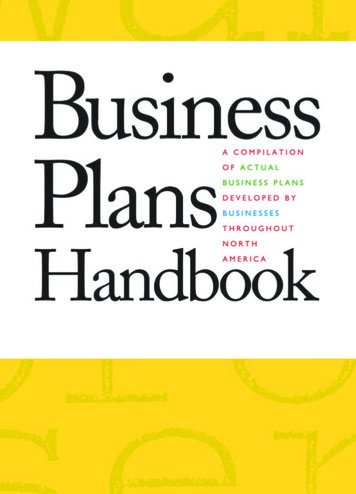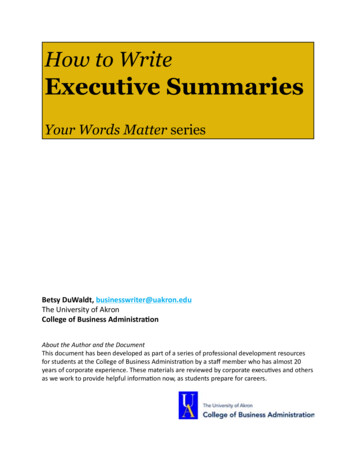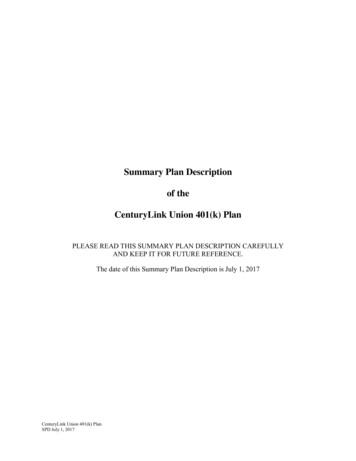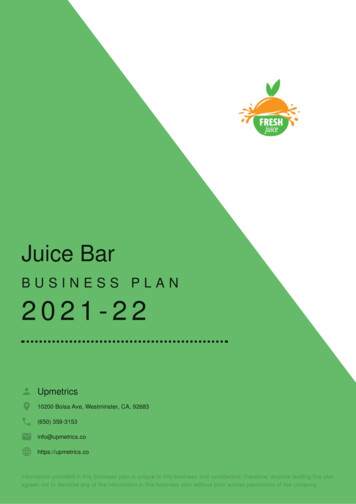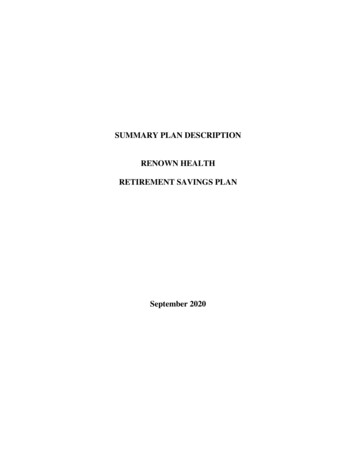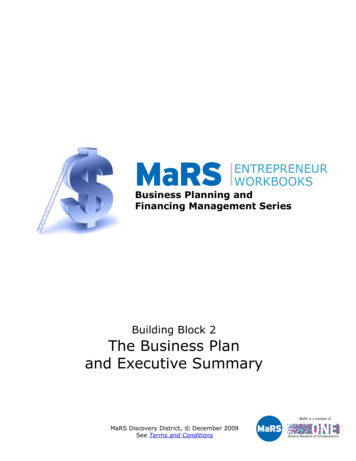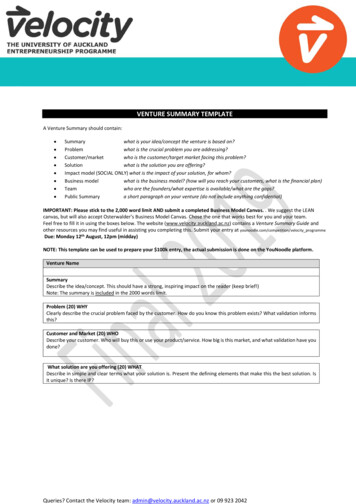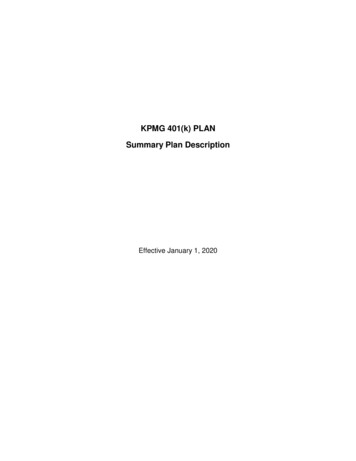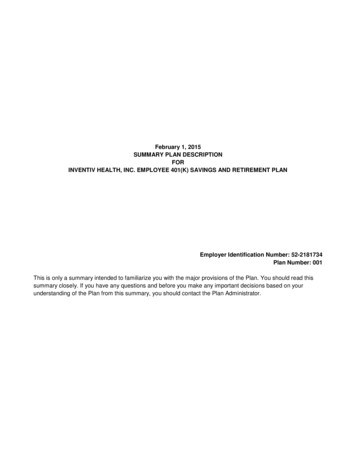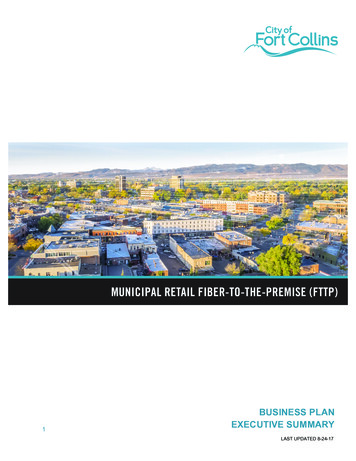
Transcription
1BUSINESS PLANEXECUTIVE SUMMARYLAST UPDATED 8-24-17
OverviewThe Broadband Business Plan is a high level planning document that outlines the data,assumptions, critical success factors, financials and risks of a City of Fort Collins MunicipalBroadband venture. The full Business Plan provides information for all community constituents,and everyone is encouraged to read it. This Executive Summary highlights the key assumptionsassociated with the City launching a broadband business. The Business Plan primarily focuseson the City creating a standalone Broadband Utility; however the City also continues to exploreproviding these services with a partner or 3rd party. The Business Plan helps provide aframework for evaluating various third-party options without including details about who wouldfulfill that role.Broadband ServicesThe City has been exploring ways to improve the reliability and speed of internet services in FortCollins since 2010 when it partnered with Colorado State University (CSU) to apply for theGoogle Fiber challenge. Though Fort Collins was not selected by Google Fiber, the broadbanddiscussions continued and were incorporated into the 2014 Fort Collins Strategic Plan. Theupdated 2016 Strategic Plan includes broadband under Strategic Objective 3.9: “Encourage thedevelopment of reliable, high speed internet services throughout the community.”Surveys consistently rank the incumbent broadband providers poorly in terms of customersatisfaction. Additionally, subsequent conversations with the top two providers indicated thatboth believed their existing speeds were adequate to meet existing consumer needs. Neitherwas willing to commit to when a full fiber network system to all premises would be implemented.[see chart] As the current private sector providers are unable or unwilling to meet the needsidentified by the community and the City’s Strategic Plan, the City of Fort Collins developed theBroadband Business Plan to address these unmet needs.The November ballot would authorize, but not require, City Council to establish a broadbandbusiness. If residents vote yes, Council, by ordinance, may direct staff to move forward witheither a retail or third-party option. Under the retail model, the City could borrow up to 150million, begin the detailed network design and planning, and ultimately implement gigabitbroadband services to all premises within the city limits. Construction would begin in 2018 withservices anticipated to begin in 2019. As neighborhoods are installed over the estimated fiveyear project, residents and businesses would have the option to purchase high qualitybroadband internet services directly from the City at competitive rates.Operating PlanThe Operating Plan section of the Business Plan highlights the basic operating components tosuccessfully provide high speed fiber services to the community. Critical operational success2
factors have been identified, including providing outstanding customer service, hiring the rightpeople, and having a time-sensitive governance structure.The City may borrow up to 150 million using Light & Power revenue bonds to meet capitalrequirements. The largest component of the capital requirement is the network constructioncost, currently estimated at 80 million, not including design costs. This amount rests largely onthe per premise passed cost (“passing cost”), as shown in the table below.Estimated Milesof Fiber# ResidentialPremises# CommercialPremisesAverage PassingCost per Premise80062,0008,000 984Residents and businesses would be able to sign up for and purchase broadband services fromthe City once fiber has been installed in their neighborhood. For modeling purposes, theBusiness Plan uses the pricing in the tables below. The pricing was developed based on bothmunicipal offerings across the country and incumbent provider offerings. This pricing reflectspublished prices as of March 2016. Pricing is very dynamic within the market and can changefrequently. Prior to launch, the market will be analyzed and pricing set accordingly. Businesseswill also have options for high capacity dedicated connections and other custom internetservices.Model Residential & Commercial PricingResidential OptionsResidential Price50 Mbps 50 per month1Gbps 70 per monthResidential speeds are symmetrical (same speed for download and upload)Commercial OptionsCommercial Price25 Mbps / 5 Mbps 59.95 per month50 Mbps / 10 Mbps 69.95 per month100 Mbps / 20 Mbps 89.95 per month1 Gbps / 500 Mbps 599.95 per monthCommercial speeds are listed as download / upload. Symmetrical options will be available for additional price.The City of Fort Collins recognizes that providing outstanding customer service is a key factor tothe success of a broadband business. In the Uptown Consultants survey of customersatisfaction with communications and utility companies within the city, Fort Collins Utilities ranksthe highest. A key component to gaining and retaining customers is the service and support3
they receive. The overriding goals of customer service are to resolve customer issues with theinitial call and remain accessible to customers at all times.The Customer Service Plan outlines how the broadband business will continue this tradition ofoutstanding customer service by hiring the right people in the right positions. For example, theCity will implement performance metrics such as 99.9925% reliability of the network, an averagecall center wait time of no more than two minutes, and a two-hour mean time to repair (duringdaylight hours only).Network ArchitectureThe City will deploy Fiber to the Premise (or FTTP) technology, which is used by all types ofservice providers. Compared to many existing internet installations, this technology uses fiber allthe way to the customer’s premise. Fiber optic cables are made up of strands of glass, as thinas a human hair, that transmit digital information using pulses of light. Specifically, the GigabitPassive Optical Network (GPON) standard will be used to make fiber available to everycustomer’s premise.In contrast, many internet services today are transmitted over copper wires, which carry lowvoltage electrical signals. Unlike fiber, bandwidth over copper wires is constrained by distanceand subject to electrical and radio source interference. Wireless technologies have also beenconsidered; however, current WiFi and 4G standards do not support high levels of bandwidth,and future technologies such as 5G and millimeter wave are still in development and years fromdeployment. To meet next-generation broadband needs, wireless technologies will bedependent upon fiber backhaul.Fiber will meet the City’s broadband needs for the next 20 years and upgrades to thenetwork’s electronics, anticipated every five to seven years, will allow speeds to increasesignificantly as needed within the market.Net Neutrality, Privacy, and SecurityThe City believes very strongly in its stance toward Net Neutrality and privacy. Both arepotential market differentiators for the City in providing services against competitors.Net Neutrality is the principle where services are not blocked, slowed down, sped up, orotherwise manipulated based on who is accessing the internet or from where. The City of FortCollins is committed to the principles of Net Neutrality.Additionally, the City is fully committed to protecting personally identifiable information andcustomer privacy. As a utility service provider, the City is sensitive to customer privacy concernsand will extend its utility policies and procedures to the new broadband business.4
In order to achieve a reliable and secure network, the City will work with third parties andvendors during (and continuing after) the design of the core network. Mechanisms such asaccess control, firewalls, anti-spoofing filters, and others will be implemented and continuallyupdated over time. While network security is a key component, physical security is also a risk.To help mitigate this, best practices will be implemented for secured, hardened sites andequipment in the field. Other security topics such as anti-virus and parental controls, forexample, are primarily associated with end-users and provide additional opportunities to marketservices to customers.Financial ModelKey components in the financial model include capital requirements, service pricing, and marketshare or take rate.Capital costs are highlighted in the table below. These costs are based on third-party andconsulting estimates. The largest cost is the network construction cost, estimated at 80 million.Estimates for construction costs are based on a neighborhood cost analysis of installing fiberaggregated into an estimated total construction cost.Capital RequirementsAmountNetwork Construction 80MBond Issuance Fees, Capitalized Interest, Financing Misc. 13MContract Installation 7MFacility & Vehicles 6MFiber Drop, Powering, ONTs 6MFixed Equipment 5MEngineering, Design, Inspection 4MBack Office Systems & Capital 1MSubtotal 122MWorking Capital 10MContingency 18MTOTAL5 150M
Pricing varies by marketplace; however, 70- 80 per month for 1Gb service is the general normacross multiple markets. A 70 per month for 1Gb service rate was used in Fort Collins marketsurveys that estimate a take rate of approximately 28% if competition is also providing a similarservice at 70 per month.The current take rate used in the Business Plan is based on a conservative research techniquefrom the packaged goods sector. Uptown Consultants have conducted several surveys over thepast couple of years, and as market conditions have changed the latest take rate, based onComcast’s release of DOCSIS3.1 and Fort Collins’ setting a price of 70 per month. Uptown’sanalysis of the survey revealed an expected 28.2% take rate.The financial model within the Business Plan is based on dozens of detailed assumptionsincluding costs of similar municipal deployments, estimated residential take rates of 28.2% (45%for commercial), 70,000 total premises, and competitively priced services. Current projectionswithin the Business Plan indicate that operating income will become positive in Year 3 andranges from 0.5 million to a high of 18.7 million. In Year 14, the City will have a positive netcash flow, 26 million in annual revenue, and will have paid off the up to 150 million dollarsoriginally borrowed. [Operations Phase Table]RisksThe City recognizes the risks associated with borrowing up to 150 million, and with buildingand managing a citywide broadband business. Overall, despite the many risks inherent in suchoperations, this Business Plan outlines how the City would mitigate the risks by using existingCity resources where practical, hiring the right people, providing outstanding customer serviceand reliable internet, and providing those services at competitive prices.In the worst case scenario, the operation would borrow the full 150 million, would not sign upany customers, and closes shop. In this scenario the Fort Collins Light & Power customerscould each pay up to an estimated 16 per month until the debt is paid off. Pages 63 to 66 ofthe Business Plan outline several sensitivity scenarios and the graph on page 65 illustrates thechange in payback timing associated with each of these scenarios.ConclusionA tremendous amount of work and due diligence has been performed in evaluating variousbusiness models and options to meet the requirements of Strategic Objective 3.9 in the 2016Strategic Plan. All constituents are strongly encouraged to read through the full Business Planand other information posted online to learn more.6
This pricing reflects published prices as of March 2016. Pricing is very dynamic within the market and can change frequently. Prior to launch, the market will be analyzed and pricing set accordingly. Businesses will also have options for high capacity dedicated connections and other custom internet services. Model Residential & Commercial Pricing

